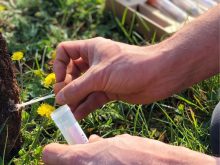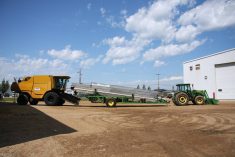Correction: A story on page 19 of the Sept. 12 issue about growing
wasabi should have read that prices are as high as $100 US per 100
grams.
COURTENAY, B.C. – The forest floor near this Vancouver Island town is a
carpet of lush green wide-leafed plants. Far from weeds, these edible
wasabi plants are the centre of a growing business for two Courtenay,
B.C., restaurateurs.
Lia McCormick, 29, and her husband Brian, 32, say wasabi is perhaps
best known in hot sauces served with sushi. They say most commercially
Read Also

Canada’s oat crop looks promising
The oat crop looks promising and that’s a good thing because demand is strong.
prepared pastes and sauces substitute the pricey Japanese plant with
Chinese mustard, horseradish and green food colouring.
Neither McCormick has a farming background, but Brian always enjoyed
gardening and visiting his uncle’s dairy farm. Lia and Brian were
raised in Ontario and each were drawn to the richness of the valley
landscape and the diversity of products grown here.
They launched the business after taking a Future Farmers course that
showed them how to write a business plan. They researched Asian cuisine
on the internet, sought help from a district agrologist and became
partners in Nature Springs Wasabi with local dairy farmer and cheese
maker Edgar Smith. His 900-acre Beaver Meadow Farm provides the acre of
treed land used to grow the plants.
Smith supplies the land and gravity-fed irrigation from nearby springs,
while the McCormicks grow and market the products.
Smith has developed wasabi cheese by using the leaves. The McCormicks
have used their vegetarian restaurant, the Bar None Café, to develop a
series of recipes with wasabi leaves and stems, including vodka,
dressings, salads and marinades.
“We are trying to come up with as many non-traditional Japanese uses
for average North American users,” Lia said. “Food is an important part
of our life.”
Wasabi can be used like horseradish, but has a sweeter aftertaste, said
Lia, who noted it contains potassium, calcium and Vitamin C.
The Japanese routinely serve it with sushi, believing it kills microbes.
The McCormicks imported the tissue stock from Taiwan and plants from
British Columbia’s Fraser Valley.
They harvested their first crop in 2001, and found buyers in a handful
of Victoria grocery stores, transporting it on a bread truck that also
delivers to the restaurant.
They now sell up to 24 pieces of wasabi a week, with prices averaging
$6 to $8 for 100 grams.
“What we’re selling it for is cheap,” said Brian, noting wasabi retails
for as much as $1,000 US per 100 g in Japan.
“We want to price it to sell and get known,” he said.
They know expansion is inevitable as their business grows, but they are
now able to keep up with orders. The plants can be harvested
year-round, so they can be picked as orders come in.
They hope to devote more time to wasabi once they sell their restaurant.
“I’d like to do more ag things and see where life leads us after that,”
Lia said.
Options include ginseng, mushrooms, fish and hydroponics.
As well as the 3,000 plants they hand planted on a cleared section of
forest, the couple grows another 300 in their backyard in town.
They dream of owning their own farm one day, but pay the bills by
working from 7 a.m. to 2 p.m. each day at the restaurant in Courtenay.
Lia called their chemical-free wasabi operation an “ecoforestry form of
farming.”
She said at least 12 cuttings can be taken from each plant, which can
later be transplanted.
Wasabi is a shade plant that grows in soil beside cold mountain streams
in Taiwan or in gravel stream beds in Japan, but a handful of growers
in Vancouver Island’s Comox Valley have found it can also grow there.
Most is grown under cover like ginseng, in greenhouses or in the
McCormicks’ case, in the shadows of alders, maples and cedar trees.
It grows best in 10 to 12¡C temperatures and will stop growing in the
heat of summer.
The McCormicks report few problems with fungus and pests. A felled tree
from a storm has been the biggest impediment to growth because shade is
essential.
Harvest is as labour intensive as hand planting, with Brian digging out
the plants with a potato fork. They are then cleaned and stored in
water to retain their crispness for up to three weeks.
Jill Hatfield, regional agrologist for B.C.’s agriculture department,
said slugs are a major challenge for wasabi because they thrive in the
moist conditions the plant requires.
Dry summers in the Comox Valley present other challenges. She said the
perennial rhizome does seem to overwinter well in a climate where
winter temperatures hover around zero.
She called wasabi a niche market best suited to serving customers close
to home such as restaurants and supermarkets where Asian communities
can be targetted.
“There’s not a huge export for the volume being grown here,” she said,
noting most growers devote less than an acre to wasabi.
She doubted it had the same export potential as ginseng because of
limited acreage, growing challenges and two-year wait from planting to
harvest.
“I think people in the valley are very aware of what happened with
ginseng and are cautious that it not happen again.”
She said the Japanese are expert wasabi producers and protect their
growers.
“Our product has a long way to go before it reaches the Japanese
standard,” she said, noting the Japanese wasabi has a less earthy
flavour because it isn’t grown in soil.
The McCormicks feel they are poised to take advantage of specialty
markets.
“We got in at the right time,” Lia said. “We are a year ahead of most
people and we have to make a go of it before the market gets flooded
and the price drops down.”
















